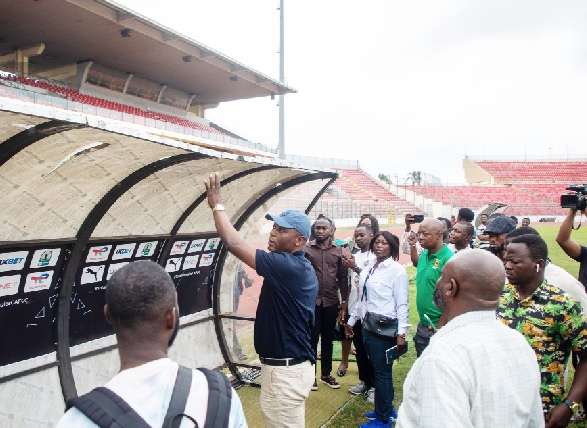When Kofi Iddie Adams took over as Ghana’s Minister of Sports and Recreation, he inherited more than just a portfolio — he stepped into a national challenge riddled with abandoned stadiums, overgrown fields and grand structures left to rot.
Now, with a fresh mandate and a new leadership team at the National Sports Authority (NSA), led by former broadcast journalist Yaw Ampofo Ankrah, one of their biggest tasks is to fix the broken system and prove that Ghana’s multi-million cedi investments in sports infrastructure were not a colossal waste.
At the heart of the mission is a simple but urgent goal — to bring Ghana’s crumbling sports infrastructure back to life through improved facility management, sustainable maintenance practices and a complete break from the culture of neglect that has plagued the sector for decades. It is a test of leadership and accountability — and one that could define the legacy of both men.
Since taking office in February 2025, Mr Adams has demonstrated a hands-on approach. He has constituted a task force to oversee the maintenance of the Accra Sports Stadium pitch and is leading a national audit of abandoned and underperforming sports facilities.
He has also courted support from key stakeholders, including a high-profile meeting with Asantehene Otumfuo Osei Tutu II, to rally traditional leadership behind the cause.
Yet, the challenges remain deep-rooted. Years of bureaucratic delays, poor planning and lack of maintenance funding and modern facility-management practices have left the NSA and the ministry struggling to keep facilities afloat.
Stakeholders across the sports fraternity are now calling for a shift toward sustainable management models, including public-private partnerships, professional maintenance teams and performance-based facility managers.
Crumbling investments, idle dreams
The minister’s ongoing nationwide facility inspection tour has revealed a sobering picture. Across the country, millions of dollars’ worth of sports projects are either deteriorating or lying idle.
Among the most glaring examples of Ghana’s infrastructure woes is the Nyinahin Youth Resource Centre in the Ashanti Region — a 5,000-seater facility described by the NSA’s own officer as “95 per cent complete on paper, yet physically deteriorating.”
On a recent tour of the site, Mr Adams found terraces swallowed by weeds, water-damaged VIP sections and idle structures meant for basketball, ICT and indoor games.
He vowed to work with the Ministry of Youth Development (funding for the Nyinahim project and other similar regional sports facilities were funded with resources from the National Youth Authority, which was an agency under the previous Ministry of Youth and Sports) to finish what was started while securing the land and resolving documentation issues that have stalled progress.
Sadly, other Youth Resource Centres in Koforidua and Ho have only been used for National Independence Day parades and have not been put to use to develop sports since they were commissioned. Despite public funds being pumped into the projects, the facilities, sadly, have also been left at the mercy of the weather.
Another stark symbol of Ghana’s crumbling sports infrastructure is the Essipon Stadium in the Western Region, constructed for the 2008 Africa Cup of Nations but now in a state of disrepair, closed to the public for nearly three years, with no concrete maintenance plan or funding in sight.
The consequences have been dire. In recent years, Ghana has suffered the humiliation of losing Confederation of African Football (CAF) certification for key stadiums — including the Baba Yara Sports Stadium and Cape Coast Stadium — due to poor upkeep.
These failures ultimately led to the dismissal of former NSA boss Prof. Peter Twumasi, whose tenure was marked by growing criticisms over the decaying state of national facilities.
While battling neglect and decay in some areas, the ministry faces a different kind of threat at the Borteyman Sports Complex — aggressive land encroachment. Built on 99 acres secured from the University of Ghana, only 43 acres remain uncontested. The rest, the minister revealed, had been swallowed up by private developers in the last three months.
The Borteyman facility, which features an Olympic-size pool, sports halls and administrative blocks, was a showpiece during the 2023 African Games. The minister has now engaged engineers and key stakeholders to develop a long-term sustainability and maintenance strategy — a model he hopes can be replicated nationwide.
Ghana’s sporting future
Ghana has spent a fortune over the past two decades building sports facilities, yet has little to show in terms of maintenance, utilisation or return on investment.
The future of these assets, and indeed the growth of Ghanaian sports, depends on a fundamental shift in how we manage, protect and profit from them.
For the new NSA boss, once a critical and influential voice in the sports media, a new kind of leadership is expected from him.
His background in media and advocacy gives him a unique platform to champion reforms, but results will ultimately speak louder than rhetoric. He must drive a new culture of accountability and avoid repeating past mistakes in the NSA’s management of the nation’s key sports infrastructure.
Stakeholders in sports expect urgent reforms that explore public-private partnerships, and a decentralised, business-like model of sports facility management where venues generate revenue through rentals, events, and partnerships, rather than waiting for government subsidies.

